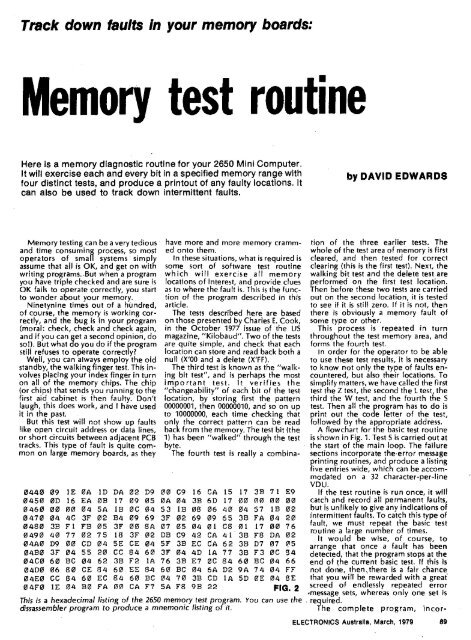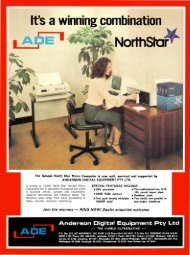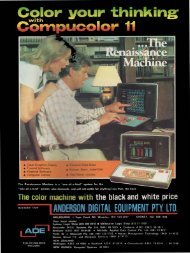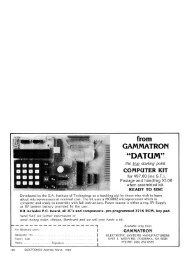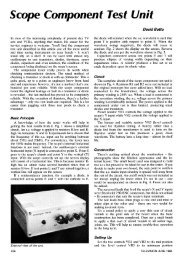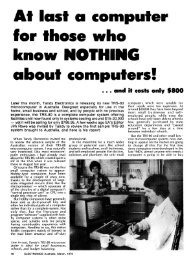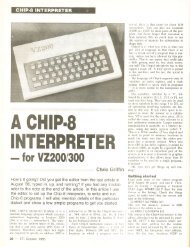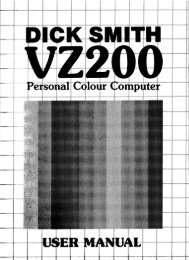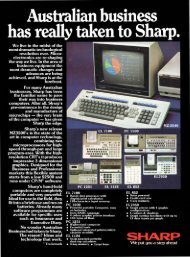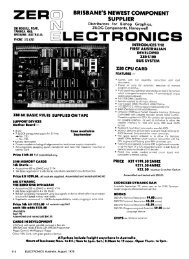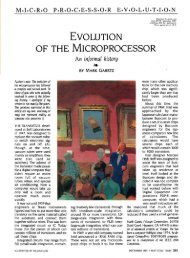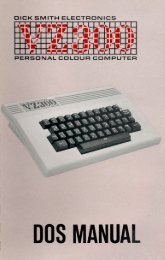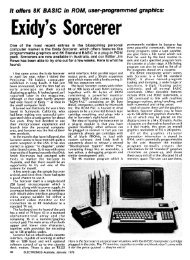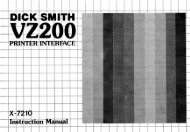The Signetics 2650 - The MESSUI Place
The Signetics 2650 - The MESSUI Place
The Signetics 2650 - The MESSUI Place
You also want an ePaper? Increase the reach of your titles
YUMPU automatically turns print PDFs into web optimized ePapers that Google loves.
Track down faults in your memory boards:<br />
Memory test routine<br />
Here is a memory diagnostic routine for your <strong>2650</strong> Mini Computer.<br />
It will exercise each and every bit in a specified memory range with<br />
four distinct tests, and produce a printout of any faulty locations. It<br />
can also be used to track down intermittent faults.<br />
Memory testing can be a very tedious<br />
and time consuming process, so most<br />
operators of small systems• simply<br />
assume that all is OK, and get on with<br />
writing programs.-But when a program<br />
you have triple checked and are sure is<br />
OK fails to operate correctly, you start<br />
to wonder about your memory.<br />
Ninetynine times out of a hundred,<br />
of course, the memory is working correctly,<br />
and the bug is in your program<br />
(moral: check, check and check again,<br />
and if you can get a second opinion, do<br />
sol). But what do you do if the program<br />
still refuses to operate correctly?<br />
Well, you can always employ the old<br />
standby, the walking finger test. This involves<br />
placing your index finger in turn<br />
on all of the memory chips. <strong>The</strong> chip<br />
(or chips) that sends you running to the<br />
first aid cabinet is then faulty. Don't<br />
laugh, this does work, and I have used<br />
it in the past.<br />
But this test will not show up faults<br />
like open circuit address or data lines,<br />
or short circuits between adjacent PCB<br />
tracks. This type of fault is quite common<br />
on large memory boards, as they<br />
0440 09 IE 0A ID DA 02 D9 00 C9 16<br />
0450 0D 16 EA OB 17 09 05 OA 04 313<br />
0460 00 00 04 5A IB OC 04 53 113 08<br />
0470 04 4C 3F 02 B4 09 69 3F 02 69<br />
0480 3B F1 FE 05 3F 00 BA 07 05 04<br />
0490 40 77 02 75 18 3F 02 DB C9 42<br />
04A0 D9 00 CD 04 5E CE 04 5F 3B EC<br />
0480 3F 04 55 20 CC 84 60 3F 04 4D<br />
04C0 60 BC 04 62 3B F2 IA 76 33 E7<br />
04D0 06 BO CE 84 60 EE 84 60 BC 04<br />
04E0 CC 84 60 EC 84 60 BC 04 70 38<br />
have more and more memory crammed<br />
onto them.<br />
In these situations, what is required is<br />
some sort of software test routine<br />
which will exercise all memory<br />
locations of interest, and provide clues<br />
as to where the fault is. This is the function<br />
of the program described in this<br />
article.<br />
<strong>The</strong> tests described here are based<br />
on those presented by Charles E. Cook,<br />
in the October 1977 issue of the US<br />
magazine, "Kilobaud". Two of the tests<br />
are quite simple, and check that each<br />
location can store and read back both a<br />
null (X'00 and a delete (X'FF).<br />
<strong>The</strong> third test is known as the "walking<br />
bit test", and is perhaps the most<br />
important test. It verifies the<br />
"changeability" of each bit of the test<br />
location, by storing first the pattern<br />
00000001, then 00000010, and so on up<br />
to 10000000, each time checking that<br />
only the correct pattern can be read<br />
back from the memory. <strong>The</strong> test bit (the<br />
1) has been "walked" through the test<br />
byte.<br />
<strong>The</strong> fourth test is really a combina-<br />
CA 15 17 3B 71 E9<br />
6D 17 00 00 00 00<br />
06 40 04 57 113 02<br />
09 65 313 FA 04 20<br />
01 C8 01 17 00 76<br />
CA 41 3B F8 DA 02<br />
CA 62 3B D7 07 05<br />
IA 77 3B F3 0C 54<br />
0C 84 60 BC 04 66<br />
6A D2 9A 74 04 FF<br />
CD IA 5D OE 04 BE<br />
04F0 1E 04 130 FA 00 CA F7 5A FS 9B 22 FIG. 2<br />
This is a hexadecimal listing of the <strong>2650</strong> memory test program. YOU can use the<br />
dissassembler program to produce a mnemonic fisting of it.<br />
by DAVID EDWARDS<br />
tion of the three earlier tests. <strong>The</strong><br />
whole of the test area of memory is first<br />
cleared, and then tested for correct<br />
clearing (this is the first test). Next, the<br />
walking bit test and the delete test are<br />
performed on the first test location.<br />
<strong>The</strong>n before these two tests are carried<br />
out on the second location, it is tested<br />
to see if it is still zero. If it is not, then<br />
there is obviously a memory fault of<br />
some type or other.<br />
This process is repeated in turn<br />
throughout the test memory area, and<br />
forms the fourth test.<br />
In order for the operator to be able<br />
to use these test results, it is necessary<br />
to know not only the type of faults encountered,<br />
but also their locations. To<br />
simplify matters, we have called the first<br />
test the Z test, the second the L test, the<br />
third the W test, and the fourth the S<br />
test. <strong>The</strong>n all the program has to do is<br />
print out the code letter of the test,<br />
followed by the appropriate address.<br />
A flowchart for the basic test routine<br />
is shown in Fig. 1. Test S is carried out at<br />
the start of the main loop. <strong>The</strong> failure<br />
sections incorporate the error message<br />
printing routines, and produce a listing<br />
five entries wide, which can be accommodated<br />
on a 32 character-per-line<br />
VDU.<br />
If the test routine is run once, it will<br />
catch and record all permanent faults,<br />
but is unlikely to give any indications of<br />
intermittent faults. To catch this type of<br />
fault, we must repeat the basic test<br />
routine a large number of times.<br />
It would be wise, of course, to<br />
arrange that once a fault has been<br />
detected, that the program stops at the<br />
end of the current basic test. If this is<br />
not done, then there is a fair chance<br />
that you will be rewarded with a great<br />
screed of endlessly repeated error<br />
•message sets, whereas only one set is<br />
required.<br />
<strong>The</strong> complete program, incor-<br />
ELECTRONICS Australia, March, 1979 89


